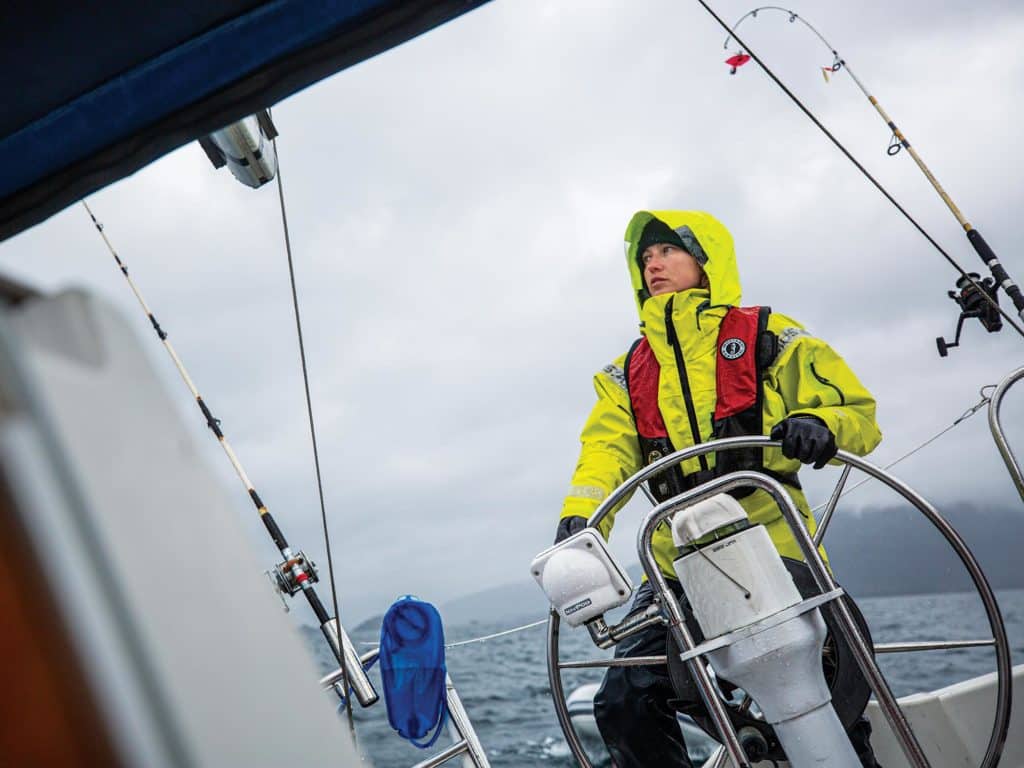
I didn’t see the wave coming that tossed me to the end of my tether; I was too busy trying to secure a headsail on the thrashing foredeck of my dad’s old J/44. We had recently peeled from a heavy J1 to a high-cut J3, and my job was to ensure that the big jib made it into its blue North Sails bag and not into “The Race,” that often-choppy slot of water separating New York’s Long Island Sound from Rhode Island’s Block Island Sound. We were roughly 60 percent of the way through the 2005 Block Island Race, and our helmsman was clearly tired as he stuffed our bow directly into an oncoming square wave.
That’s when my sea boots left the deck. I landed atop my buddy, someplace near the port shrouds. I was happy that I hadn’t cracked my head on anything stainless steel or fiberglass. My buddy was happy that I was still on the boat. Two minutes later, we were back in the business district, sorting out the sail.
Yes, I finished my watch as wet as a rat in a drain ditch, but there’s no question that my tether, which was clipped to a foredeck padeye, saved my bacon. Thankfully, my PFD didn’t deploy unnecessarily, and I gained confidence in the system.
Many years have slipped astern since that Block Island Race, but the basics of personal flotation devices are the same, as is the safety they afford.
PFDs come in five types. Type I is for cruising, racing and fishing offshore, and for use by commercial ships, or when boating alone, or in stormy conditions. It can be inherently buoyant or inflatable (or a hybrid of the two), and provides a minimum of 22 pounds of flotation.
Type II typically refers to the chunky orange-foam affairs with at least 15.5 pounds of positive flotation, but the type can also encompass some inflatable vests. It is best for daysailing in small boats. Type III is for activities such as sailing regattas, dinghy races, water-skiing, fishing, canoeing and kayaking, and provides at least 22.5 pounds of positive buoyancy. Type IV, with 16.5 pounds of buoyancy, is a throwable device such as a horseshoe buoy.
Then there’s Type V, which has 15.5 to 22.5 pounds of buoyancy, is inflatable or hybrid inflatable and inherently buoyant, and is designated as a “special-use device” for activities such as inshore and offshore sailing.
This article will consider eight Type V PFDs. Their designs may differ, but they all rely on an empty air bladder, a filled and sealed carbon dioxide cartridge, and a release mechanism. Some employ water-soluble discs or capsules that trigger the spring-loaded firing pin that pierces the carbon dioxide cartridge, while others have a hydrostatic mechanism that fires when the vest is submerged in a few inches of water (water pressure on the hydrostatic sensor serves as the tipping point). While both types work well, hydrostatic systems are less likely to fire accidentally if exposed to huge amounts of on-deck water.
Additionally, Type V PFDs all have a manual-release rip cord and an oral inflation tube in case the built-in systems fail, or if the air bladder needs topping off later. In all cases, it’s important to read the manufacturer’s care and use instructions, and to replace key components per the manufacturer’s guidelines.
I evaluated these PFDs by considering their features, wearing them with sailing gear, and floating in them at my local pool. Here’s what I found.
Mustang Survival MIT 100 Automatic Inflatable PFD
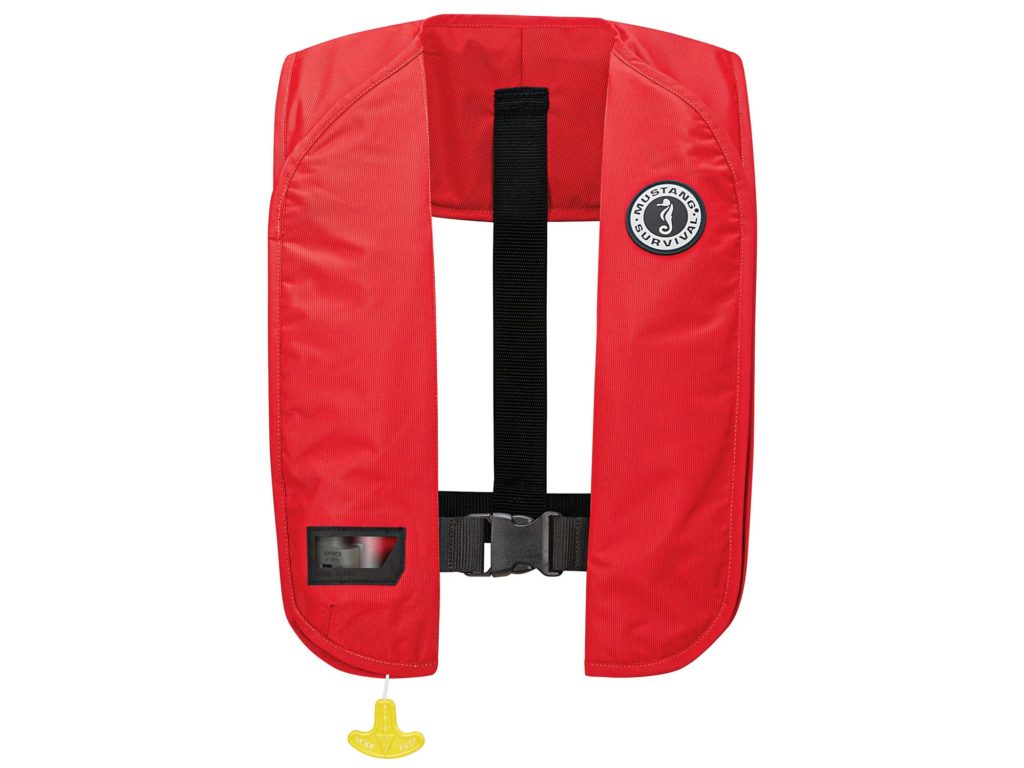
This PFD has more going on than initially meets the eye. Most PFDs employ an inner air bladder protected by an exterior jacket that breaks away when the jacket inflates. This US Coast Guard-approved PFD instead has Mustang Survival’s Membrane Inflatable Technology and the company’s clever “one-fold design.” The combo means the PFD’s air bladder is physically housed inside a protective jacket. When the jacket deploys, two Velcro strips rip away, revealing the jacketed and inflated bladder. This same design makes the MIT 100 the easiest PFD in this article to repack: Just bleed the air, rearm the carbon dioxide cartridge and trigger mechanism, and fold over two flaps. While the MIT 100 doesn’t have a tether hardpoint, its lower price point could make it a good choice for inshore cruising or blue-sky daysailing. The PFD’s waist belt is easily adjustable for guests, and an inspection window lets you evaluate the firing mechanism’s status. In the water, this PFD is comfortable, but there isn’t much behind-the-neck head support.
Mustang Survival HIT Hydrostatic Inflatable PFD With Sailing Harness
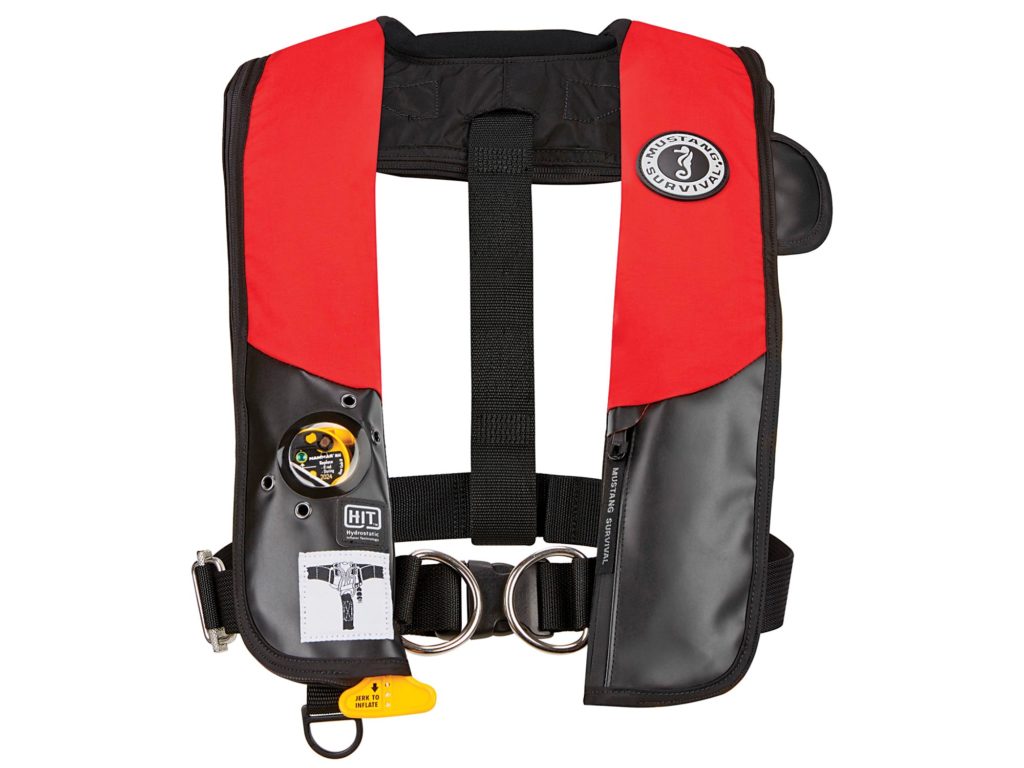
This is an affordable PFD with a full sailing harness, a hydrostatic trigger mechanism, and US Coast Guard approval. Its air bladder comes bundled in a sturdy jacket built from 500-denier Cordura, and it sports a neoprene-lined collar. A beefy harness with two equally beefy stainless-steel D-rings allows for attaching a tether. There’s an inspection window for checking the trigger mechanism’s status, a strobe-light holder, and Mustang’s SecureZip breakaway jacket-closure system. The PFD’s Hammar-built hydrostatic sensor needs to be submerged to a depth of at least 4 inches to fire its carbon dioxide cartridge (read: no accidental deployments). Once inflated, the PFD delivers 38 pounds of buoyancy, and its high-visibility air bladder and even higher-visibility SOLAS-level reflective tape help ensure that you’ll be seen. The PFD also has a tidy-size zippered pocket. One consideration, however, is that rearming this PFD is more involved (Mustang’s instruction video runs 12 minutes, 30 seconds), but it’s a worthwhile trade-off. In the water, with the crotch strap attached, this PFD did a great job of orienting me face up and providing head support.
Mustang Survival EP 38 Ocean Racing Hydrostatic Inflatable Vest
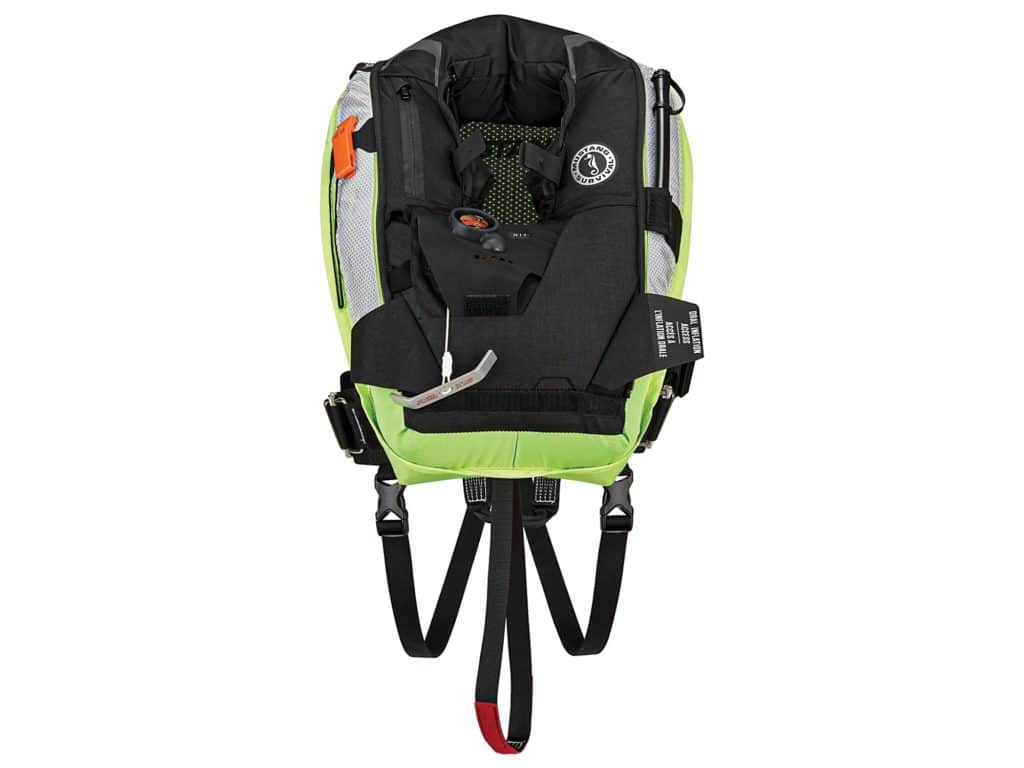
As its moniker suggests, this PFD is made to take you from offshore racing on wet, fast boats to adventure cruising in wet climes. The US Coast Guard-approved PFD has a Hammar-built hydrostatic inflation mechanism, a sturdy sailing harness with an easily adjusted (even when wearing gloves) waist belt, a soft-loop tether-attachment point, and a small, integral backpack-style pod that houses the vest’s shoulder straps, spray hood, and removable crotch straps. While the backpack pod feels a bit bulky, its contents are a treasure trove when floating. This pullover-style PFD also has a low-profile design that allows for unencumbered athletic movement, and a zippered pocket that can house emergency essentials such as lights or electronics. There’s also a stitched-in lifting loop for emergency MOB retrievals. The vest’s hydrostatic mechanism is prominently situated on the front, behind a three-dimensional inspection window, for a military-esque aesthetic. The EP 38 felt great to float in, especially once I deployed the crotch strap and spray hood.
Onyx A/M-24 and A/M-24 All Clear
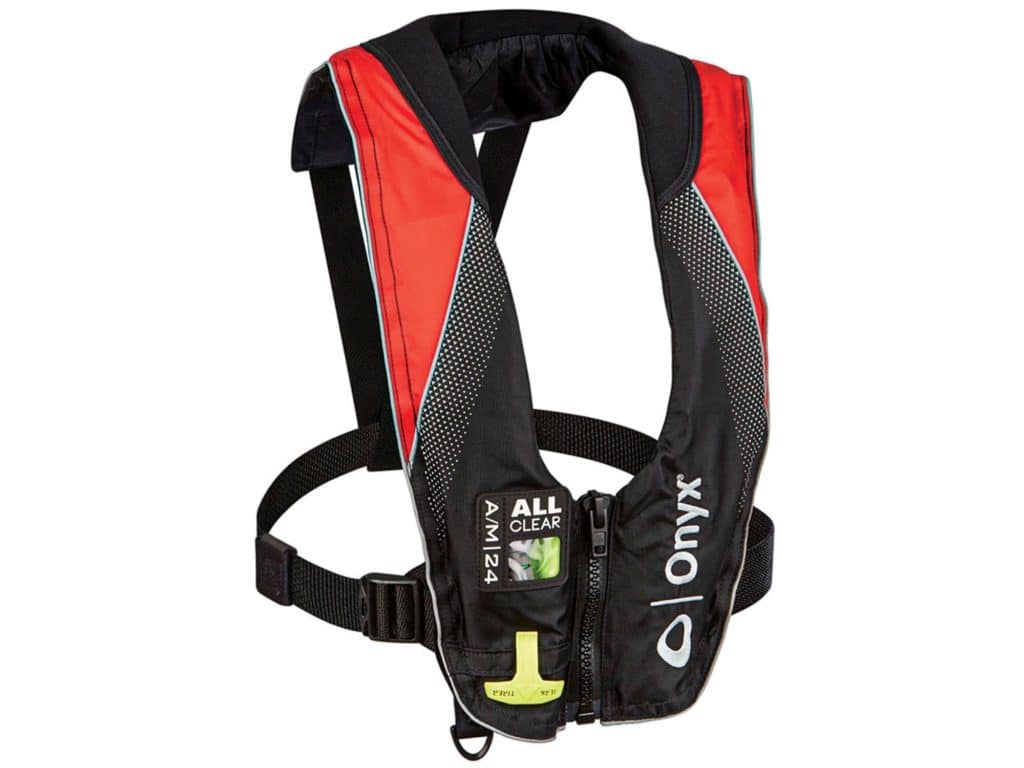
Consider these PFDs if you’re seeking a basic Type V PFD and don’t need a tether attachment. Both are US Coast Guard-approved, employ lozenge-style automatic firing mechanisms, and can be used in automatic or manual mode, or converted to manually operated PFDs (which can be useful aboard wet boats, so long as the MOB is conscious and able to pull the manual-inflation rip cord). Both vests also have a Velcro-enclosure system, high-visibility inflation chambers, and wide neoprene necklines that felt comfortable when worn with a T-shirt, and that added padding when worn with a jacket.
While the two PFDs are similar in design and features, there are some differences. The A/M 24 is no-frills, with a side-release waist buckle and a plastic D-ring attachment that’s not for use with a tether, but it is useful for attaching a handheld VHF radio (see CW, August 2022) or an emergency beacon. The A/M 24’s firing mechanism is hidden in the Velcro-enclosed outer jacket, meaning a user must unpeel several inches of hooks and loops to ensure that the jacket is properly armed.
The A/M-24 All Clear has some upgrades, most notably a plastic inspection window on the jacketed front that gives an at-a-glance status report of the firing mechanism. Additionally, the A/M-24 All Clear has a zippered front enclosure, a beefier nylon waist belt, and a smaller-profile D-ring attachment (also not for use with a tether).
Neither of these PFDs has crotch straps, and this absence was noticeable when floating. In our test pool, the A/M-24 All Clear failed to trigger automatically for almost two minutes.
Onyx A/M-33 All Clear With Harness
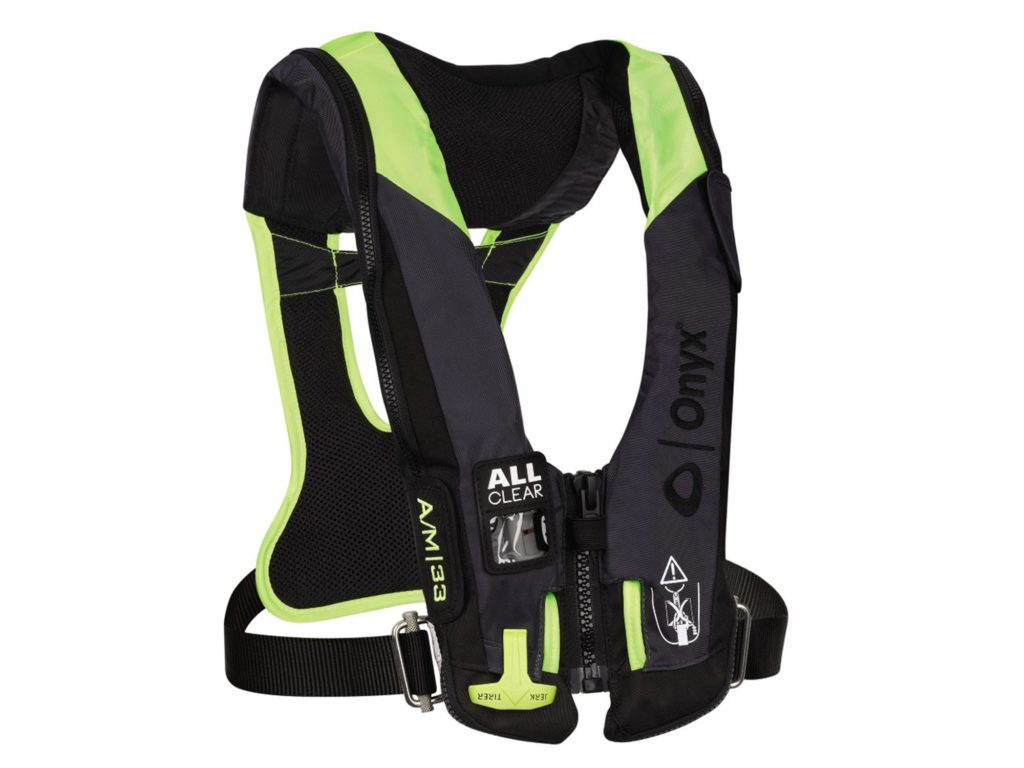
If you’re ready to go offshore, this PFD could be right for you. The US Coast Guard-approved vest has a sailing harness with dual soft loops (port and starboard) for attaching a tether, a beefy nylon waist belt with sturdy stainless-steel adjusters, a high-visibility inflation chamber, a breakaway zipper enclosure, and a window for at-a-glance status on the vest’s firing mechanism. The vest’s back has shoulder-strap padding that doubles as ultraviolet protection, and also adds a bit of cushioning when leaning back in the cockpit or lounging on deck.
This PFD also sports a zippered front closure (with an elasticized zipper garage to ensure that the vest stays put) and a thin neoprene neckline for extra comfort. As with its little brothers, the A/M-33 All Clear can be operated in automatic/manual or fully manual modes, but it differs by delivering 35 pounds of buoyancy once fully inflated. This extra lift was immediately noticeable when floating; there’s no crotch strap, but its absence wasn’t an issue.
Spinlock Deckvest LITE+
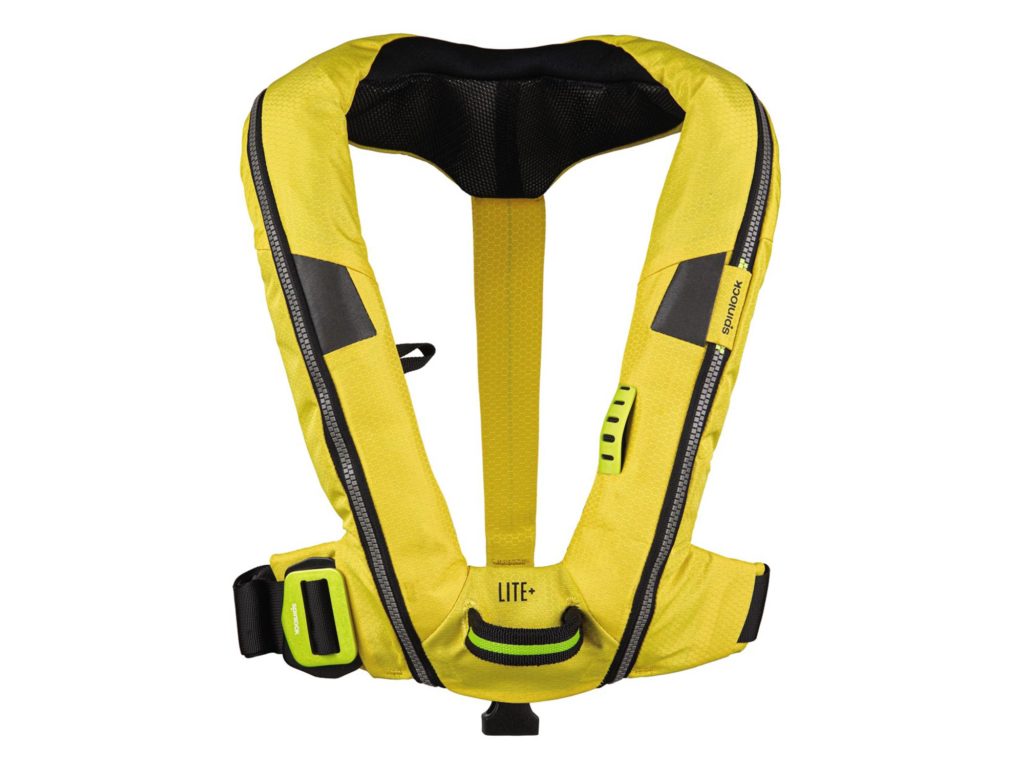
Lightweight, low-profile, unencumbering—this PFD’s design (when packed) is wide at the neck, allowing about 165 degrees of head rotation without chin contact. The bit that does contact your neck is neoprene-covered for comfort. This is a side-entry PFD that arrives in automatic/manual mode, but it can be converted to manual-only with a kit. The LITE+ has a single crotch strap with a hidden receptacle clip, and it comes with loops for attaching Spinlock’s optional Chest Pack, which is handy for storing emergency essentials.
The PFD also has Spinlock’s clever breakaway zipper system, a soft-loop attachment point and—when deployed—an emergency haul loop. The LITE+ can be upgraded with Spinlock’s Pylon Light, which is a water-activated flashing LED; Lume-On patches to illuminate the inflated bladder; and a spray hood. Customers also can purchase the LITE+ with an integrated Ocean Signal MOB1 AIS beacon. The LITE+ is approved to CE and ISO standards. In the water, the Deckvest LITE+ provided good head support and face-up orientation, especially once the crotch strap was properly deployed.
Spinlock Deckvest 6D HRS
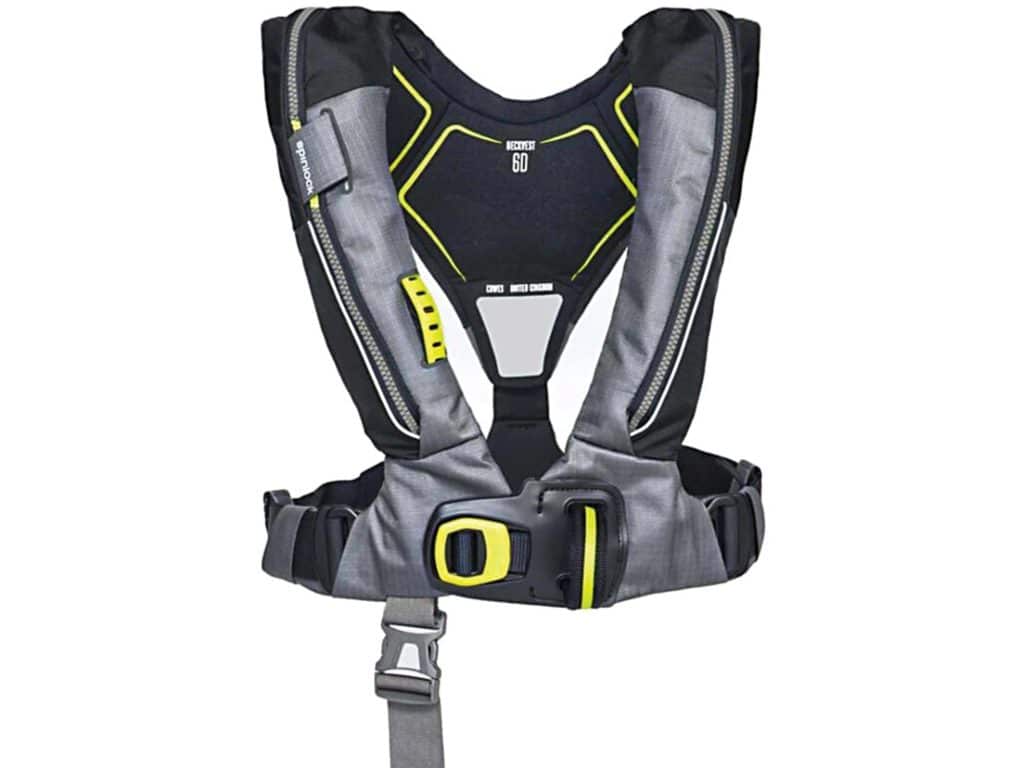
There’s a lot to like about this innovative PFD. It’s built to CE and ISO standards. Once inflated, it delivers 170 newtons of positive buoyancy. It can be ordered with 275 newtons, but this adds bulk. The PFD has Spinlock’s Pro Sensor Elite firing mechanism, which activates only when water flows upward into its cap, so there are no wave or rain deployments. It also has Spinlock’s Harness Release System, which has a load-releasable tether hardpoint. If the MOB is getting dragged, she pulls a rip cord and immediately separates from her tether.
Once in the water, the automatic/manual vest opens to reveal a spray hood, emergency haul loop, Spinlock Pylon 360 light, and Spinlock Lume-On air-bladder light. A crotch strap resides in a small pouch on the back of the PFD’s harness. Additionally, there’s a user-friendly waist-belt buckle, an inspection window for the firing mechanism, and compatibility with Ocean Signal’s MOB1 AIS beacon. The Deckvest 6D was one of the most comfortable PFDs to float in, and its design made accessing the spray hood a snap.








